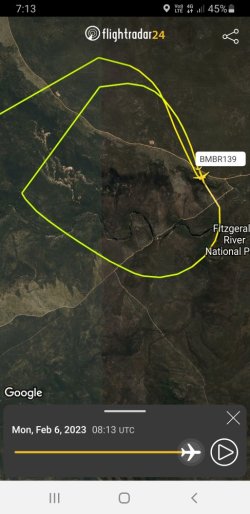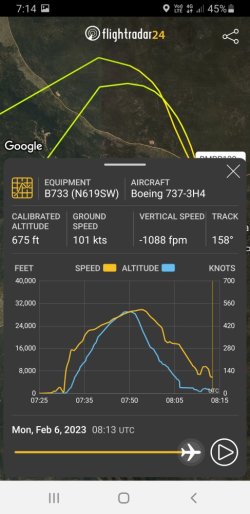That FR24 trace shows climb out ok until sudden deviation to right and then gradual loss of speed and altitude with a few spikes in rate of descent.
It does not show that at all. Here is a link to FR24 and its data. Note that the image showing the track is not north aligned (north is on the right side of the image).
A Coulson 737 Fireliner suffered an accident while fighter bush fires in Australia. The two pilots aboard were able to walk away.

www.flightradar24.com
Possible control surface/structural failure after load release?
Anything is possible, but unless you have sources beyond the media, I expect that there is no data to support this bit of conjecture. Have a theory, by all means, but base it on something.
What can be worked out from the FR24 data, that might support any theory?
Firstly the crew survived, so it must have been more or less wings level, and under control. They were actually bombing near a ravine, so they must have been lucky enough to have come down on level(ish) terrain.
The approximate wind can be worked out by comparing the ground speed from the crash heading to it's reciprocal. There were two passes, so you can do it twice. That gives a headwind of about 20 knots (half of the difference between the two g/s values).
On the previous pass, at the last GPS position, their altitude was 650-675' and ground speed about 118 knots. Sink rate was roughly 400 fpm. On the accident pass though, the ground speed was down around 100 knots, and the sink rate is quite a bit higher, at around 1,000 fpm. For reference, note that an approach to landing in an airliner will be at about 600-700 fpm, and that 1,000 is generally considered the cutoff for an unstable approach. From our rough wind calculation, the IAS on the first pass would have been about 135-140 knots, but on the second around 120 knots. The angle of the approach on the first pass would have been around -2º, but on the second it's going to be around -4 to -5º. The upshot of all of this, is that the aircraft is in a lower energy state, and will need at greater pitch change to arrest the rate of descent. That will equate to requiring more altitude.

 www.abc.net.au
www.abc.net.au



















